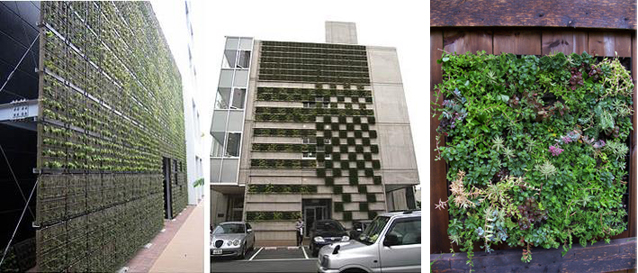Urban Permaculture: Rooftop Gardening
These notes form a part of sanjeev_shankar's research, which is summarised in his research report
Unlike the roofing industry, there are no accepted standards for vertical gardens or green wall infrastructure and this has resulted in some interesting customised methods. One of the leading designers of vertical gardens is Patrick Blanc. Using a scientific and deeply researched process, Patrick conducts studies in tropical areas, primarily on “understory” plants which receive minimal sunlight beneath the rainforest canopy, and can thus be presumed to grow in humid indoor areas where sunlight is limited. He figures out which species will thrive in the environment for which he’s commissioned to design, then configures the garden such that it’s self-sufficient, requiring only quarterly maintenance. The Vertical Garden in this case is composed of three parts: a metal frame, a PVC layer and felt. There is no soil. The metal frame is hung on a wall or can be self-standing. It provides an air layer acting as a very efficient thermic and phonic isolation system. A 1cm thick PVC sheet is then riveted on the metal frame. This layer brings rigidity to the whole structure and makes it waterproof. After that comes a felt layer made of polyamide that is stapled on the PVC. This felt is corrosion-resistant and its high capillarity allows a homogeneous water distribution. The roots are now growing on this felt. Watering is provided from the top with the tap water being supplemented with nutrients. The process of watering and fertilisation is automated. The whole weight of the ‘Vertical Garden’, including plants and metal frame, is lower than 30 kg per square meter.1)2)
Another alternative utilizes the principles of hydroponic gardening in the vertical dimension. A hydroponic system eliminates soil and reduces the weight of the garden, an important consideration for any structure that is part of or affixed to the building envelope. Here, the vertical garden is often designed to minimize water use through a recycling procedure that allows the same water and nutrient source to be reused for several applications. The plants are rooted in rockwool: an inorganic material (made from igneous rock) which has very good moisture and air retention capacities. It is used to anchor the plant and to provide moisture, through contact, by the distribution of the liquid nutrient solution. However, other material such as cocoa fiber may be acceptable too and be a superior rooting media.
Some other interesting developments in the vertical garden segment:3)
- The company ELT4) makes living wall systems as products available for immediate purchase. For example they offer panels in varying sizes with integrated wall brackets and low maintenance, drought resistant plants for sale.
- Shimizu Corp., a Japanese construction company, and Minoru Industrial Co., an agricultural machinery manufacturer, co-developed 'Parabienta', a light-weight and low-cost wall greening system. The system combines panel-type planting units to form a wall. The culture soil that forms the base of the planting unit is a compound that forms a solid but lightweight mass when heated, and comes in the shape of 5-centimeter thick sponge-like sheet of polyester-blended soil that has been heated with steam and molded. It has good water retention and drainage properties, and various kinds of plants can grow on this lightweight, shallow planting base. This culture base is the key to making this a lightweight and inexpensive unit-type wall greening system.5)

